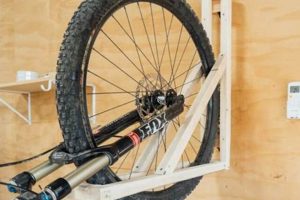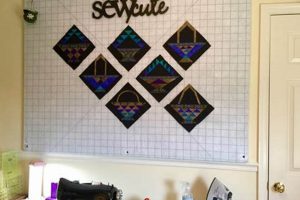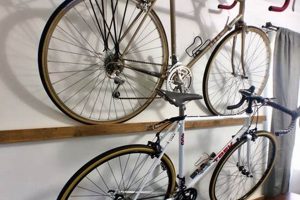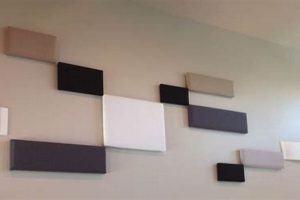The integration of a television and an artificial or traditional hearth into a single wall unit represents a popular contemporary design choice. Such a structure typically incorporates framing, sheathing, and a decorative facade, housing both a screen for viewing media and a feature simulating a fire. This combination can serve as a central focal point in a living space, offering both visual entertainment and aesthetic warmth.
This design trend offers benefits such as space optimization, concealment of wiring, and creation of a unified aesthetic. The inclusion of a focal point can enhance a room’s perceived value and appeal. Historically, the hearth has represented a gathering place, and this modern iteration adapts that concept to incorporate modern entertainment technology. Furthermore, customization options allow homeowners to tailor the appearance to match existing decor or achieve a specific design style.
Subsequent sections will explore key considerations for constructing such an integrated wall unit, including safety precautions, material selection, design considerations, and installation techniques.
Guidance for Integrated Entertainment Center Construction
The following points offer guidance for individuals undertaking the project of constructing an integrated media and simulated-hearth feature. Adherence to these guidelines can promote a safe and visually appealing result.
Tip 1: Planning and Measurement: Prior to initiating construction, meticulous planning and accurate measurement of the designated space are essential. Account for television dimensions, fire feature requirements (including safety clearances), and desired overall proportions.
Tip 2: Structural Integrity: Ensure that the supporting structure possesses adequate strength to bear the weight of the television, fire feature, and all building materials. Reinforcement may be necessary depending on the chosen materials and design.
Tip 3: Electrical Safety: All electrical work must comply with local building codes. Engage a certified electrician to handle wiring for the television, fire feature (if electric), and any integrated lighting to mitigate the risk of electrical hazards.
Tip 4: Ventilation Considerations: Electric fireplaces and media components generate heat. Proper ventilation should be incorporated into the design to prevent overheating and potential equipment damage.
Tip 5: Material Selection: Choose building materials that are appropriate for the intended use and environment. Consider factors such as fire resistance, durability, and aesthetic compatibility. Common choices include drywall, wood, stone veneer, and metal.
Tip 6: Cable Management: Implement a system for concealing and managing cables to maintain a clean and organized appearance. This may involve running cables through the wall framing or utilizing cable management accessories.
Tip 7: Fire Safety Compliance: If incorporating a gas fireplace, adhere strictly to manufacturer guidelines and local codes regarding venting, gas line installation, and safety shut-off mechanisms. A professional gas fitter must handle these installations.
Careful execution of these recommendations contributes to a successful, safe, and aesthetically pleasing integrated entertainment center. Prioritizing structural integrity, electrical safety, and adequate ventilation will ensure a durable and functional result.
The subsequent sections of this article will delve into specific design styles and material options to further inform project planning.
1. Structural Integrity
Structural integrity constitutes a foundational element in the realization of any integrated television and simulated-hearth wall unit. The design must account for the cumulative weight of all components to ensure stability and prevent potential failure.
- Load Distribution
The weight of the television, fire feature, and framing materials must be evenly distributed across the supporting structure. Insufficient load distribution can lead to localized stress concentrations, increasing the risk of collapse. For example, a heavy stone veneer applied to a poorly supported frame could compromise the entire structure. Understanding load paths and employing appropriate support members, such as studs or joists, is crucial.
- Material Strength
The selected building materials must possess sufficient strength to withstand the applied loads. Wood, steel, and concrete each offer varying levels of load-bearing capacity. The appropriate material choice depends on the specific design and the anticipated weight of the components. Inadequate material strength can result in deformation, cracking, or complete structural failure.
- Connection Details
The connections between individual structural elements must be robust and reliable. This includes the use of appropriate fasteners, such as screws, nails, or bolts, and ensuring proper engagement. Weak or improperly executed connections can compromise the overall stability of the structure. For instance, inadequately secured framing members can lead to racking and instability.
- Foundation Support
The supporting wall or floor must be capable of bearing the additional weight imposed by the integrated unit. Insufficient foundation support can lead to settling, cracking, or structural damage to the existing building. Assessing the existing foundation and providing reinforcement, if necessary, is paramount.
Addressing these facets of structural integrity is not merely a matter of aesthetic preference but a critical safety consideration. A structurally unsound integrated television and fire feature poses a potential hazard to occupants and the building itself. Rigorous planning and adherence to sound engineering principles are essential for a safe and durable result.
2. Electrical Compliance
Electrical compliance is a non-negotiable aspect of any “diy fireplace wall with tv” project. Integrating electrical components such as televisions, electric fireplaces, and associated wiring into a wall structure necessitates strict adherence to local electrical codes and safety standards to prevent hazards and ensure proper functionality.
- Permitting and Inspections
Obtaining the necessary permits from local authorities is often a prerequisite for electrical work. These permits ensure that the project is subject to inspection by qualified personnel. Inspections verify that the electrical installation meets code requirements, minimizing the risk of fire or electrocution. Failure to obtain permits or pass inspections can result in fines, project delays, or even the requirement to dismantle non-compliant installations.
- Wiring and Circuitry
The wiring used within the wall structure must be appropriately sized for the intended electrical load. Overloaded circuits are a common cause of electrical fires. Proper grounding is also essential to protect against electrical shock. Using the correct gauge wire, employing proper wiring techniques, and ensuring adequate circuit protection, such as circuit breakers or fuses, are critical for safe operation. Additionally, concealing wiring within walls mandates the use of approved wiring methods, such as conduit or non-metallic sheathed cable (Romex), to protect the wiring from physical damage.
- Outlets and Receptacles
The placement and type of electrical outlets and receptacles must comply with electrical code requirements. Outlets should be positioned strategically to minimize the use of extension cords, which can create tripping hazards and overload circuits. Ground Fault Circuit Interrupter (GFCI) outlets are often required in areas where moisture is present, such as near fireplaces or water features. Tamper-resistant receptacles are recommended to prevent children from inserting objects into the outlets.
- Electric Fireplace Installation
If an electric fireplace is included in the design, its installation must adhere to the manufacturer’s instructions and electrical code requirements. The fireplace must be connected to a dedicated circuit of sufficient amperage. Proper ventilation around the fireplace is crucial to prevent overheating. The fireplace should also be positioned at a safe distance from combustible materials, such as curtains or furniture.
The multifaceted nature of electrical compliance underscores the need for either a thorough understanding of electrical codes or the engagement of a qualified electrician. A “diy fireplace wall with tv” project with improperly installed electrical systems poses significant safety risks and can lead to costly repairs or legal liabilities. Therefore, prioritizing electrical compliance is paramount for a safe and functional outcome.
3. Ventilation Strategy
Effective ventilation represents a critical design element in the construction of an integrated television and simulated-hearth wall unit. The strategic implementation of airflow management mitigates the risk of overheating, prolongs the lifespan of electronic components, and ensures safe operation.
- Heat Dissipation from Electronics
Televisions, particularly larger models, generate substantial heat during operation. Confined spaces within the wall unit can trap this heat, leading to increased component temperatures and potential performance degradation or premature failure. A ventilation strategy facilitates heat dissipation, maintaining optimal operating temperatures. Examples include incorporating ventilation grilles or fans to promote airflow around the television. The implications of inadequate ventilation include shortened lifespan of the television and potential fire hazards.
- Electric Fireplace Thermal Management
Electric fireplaces produce heat as an inherent function. While designed with safety features, prolonged operation within an enclosed space can still result in elevated temperatures. Proper ventilation prevents overheating of the surrounding structure and minimizes the risk of fire. Strategies include ensuring adequate clearance around the fireplace unit and incorporating vents to allow heat to escape. Neglecting this facet could lead to damage to the wall structure or create a fire hazard.
- Airflow Circulation Patterns
Effective ventilation requires a well-defined airflow pattern to ensure efficient heat removal. Passive ventilation relies on natural convection, while active ventilation employs fans to force air circulation. The placement of intake and exhaust vents is crucial for establishing a continuous airflow path. For instance, locating intake vents at the bottom of the unit and exhaust vents at the top promotes the upward movement of heated air. Poorly planned airflow can create stagnant zones where heat accumulates.
- Moisture Control
Ventilation also plays a role in moisture control within the wall unit. Condensation can form on electronic components, leading to corrosion and electrical damage. Air circulation helps to prevent moisture buildup, particularly in humid environments. Incorporating vents or using dehumidifying materials can mitigate the risk of moisture-related issues. Ignoring moisture control can compromise the long-term reliability of the electronic components.
The implementation of a comprehensive ventilation strategy within the “diy fireplace wall with tv” construct is not merely an aesthetic consideration but a fundamental safety and performance requirement. Neglecting ventilation can lead to equipment failure, structural damage, and potential fire hazards, underscoring the importance of careful planning and execution.
4. Material Selection
Material selection for an integrated television and simulated-hearth wall is a critical process influencing both aesthetic appeal and functional performance. The chosen materials dictate durability, safety, and the overall visual impact of the finished structure.
- Fire Resistance Properties
Materials near the simulated hearth, particularly those directly surrounding an electric or gas fireplace insert, necessitate inherent fire resistance. Non-combustible materials like stone, brick, or fire-rated drywall minimize the risk of fire propagation. Incorrect material choices can lead to rapid flame spread and compromise structural integrity. Building codes often specify minimum fire-resistance ratings for materials used in proximity to heat-generating appliances.
- Structural Load Capacity
The framing and sheathing materials must possess adequate load-bearing capacity to support the weight of the television, fire feature, and any decorative elements. Wood framing, for example, requires proper sizing and spacing of studs to prevent deflection or collapse. Steel framing offers a higher strength-to-weight ratio but may present challenges in terms of cost and installation. Inadequate load capacity can result in structural failure and pose a safety hazard.
- Aesthetic Compatibility
Material selection should align with the desired aesthetic style of the room. Options range from rustic wood finishes to sleek, modern surfaces like metal or glass. The chosen materials should complement the existing decor and create a cohesive visual experience. A mismatch in material styles can detract from the overall design and create a jarring effect. Considerations include color, texture, and finish.
- Moisture Resistance
Materials used in areas prone to moisture exposure, such as basements or rooms with high humidity, should exhibit moisture resistance. Moisture-resistant drywall, treated lumber, and waterproof membranes prevent the growth of mold and mildew. Failure to address moisture concerns can lead to structural damage, health hazards, and aesthetic degradation.
The integration of these material facets ensures that the “diy fireplace wall with tv” project achieves a balance of safety, durability, and visual appeal. Careful consideration of material properties and their interaction contributes to a successful outcome.
5. Cable Management
Effective cable management is a crucial, often underestimated, component of any successful “diy fireplace wall with tv” project. The visual clutter associated with exposed wires and cables detracts significantly from the aesthetic appeal of the integrated design. Furthermore, haphazard cable arrangements pose safety hazards and complicate troubleshooting or future modifications. Neglecting cable management can transform a visually striking centerpiece into an eyesore, diminishing the overall value and enjoyment of the installation. The integration of multiple electronic devices television, streaming devices, gaming consoles, and potentially the electric fireplace itself necessitates a well-planned strategy for concealing and organizing numerous cables. A disorganized mass of wires not only presents an unsightly appearance but also increases the risk of accidental disconnections or damage to the cables themselves.
Practical implementation of cable management involves several strategies. Concealing cables within the wall cavity is a common approach, requiring careful planning during the framing stage. Running cables through dedicated conduits or using in-wall rated wiring ensures both safety and ease of future access. Alternatively, surface-mounted cable raceways or decorative cord covers offer a less invasive solution for hiding cables along the wall’s surface. Organizing the cables behind the television and other components using Velcro straps, zip ties, or cable sleeves prevents tangling and facilitates a cleaner appearance. The selection of appropriate length cables minimizes excess slack and further reduces clutter. In a real-world example, a homeowner meticulously planned the cable routing for their integrated wall unit, concealing all wiring within the wall and utilizing a central cable management box to organize connections. This resulted in a seamless, uncluttered aesthetic that enhanced the overall visual appeal of the room. Conversely, another individual neglected cable management, resulting in a tangle of wires that detracted from the otherwise well-designed wall unit.
In summary, thoughtful cable management is integral to the success of a “diy fireplace wall with tv” project. It contributes significantly to the aesthetic appeal, enhances safety, and simplifies future maintenance or modifications. Challenges often arise in retrofitting existing installations or dealing with complex cable configurations. However, the benefits of a well-executed cable management plan far outweigh the initial effort. Overlooking this aspect can undermine the visual impact and functionality of the entire integrated wall unit.
6. Aesthetic Harmony
Aesthetic harmony, in the context of a “diy fireplace wall with tv,” transcends mere visual appeal. It represents the successful integration of diverse elements to create a unified and pleasing composition. Achieving aesthetic harmony requires careful consideration of color palettes, material textures, and overall design principles to establish a cohesive visual experience.
- Color Palette Integration
The color scheme selected for the wall unit must complement the existing decor of the room. A harmonious palette avoids jarring contrasts and promotes a sense of visual unity. For example, employing a neutral color base with accent colors that echo those found in the surrounding furniture and accessories can create a seamless transition. A poorly chosen color palette can result in a discordant and visually unappealing space, undermining the intended focal point.
- Material Texture Coordination
The textures of the various materials used in the construction of the wall unit should work together to create visual interest without overwhelming the senses. Combining smooth surfaces with textured elements, such as stone veneer or reclaimed wood, can add depth and character. However, an excessive mix of textures can result in a cluttered and chaotic appearance. The key is to strike a balance between visual stimulation and cohesive design.
- Scale and Proportion Considerations
The dimensions of the television, fireplace, and surrounding structure must be proportionate to the size of the room. A massive wall unit in a small space can feel overwhelming, while a diminutive design in a large room may appear insignificant. Careful attention to scale and proportion ensures that the wall unit integrates seamlessly into the environment, enhancing rather than detracting from the overall aesthetic. Mathematical ratios, such as the golden ratio, can inform design decisions related to proportion.
- Style Consistency
The design style of the wall unit should align with the overall architectural style of the home. A modern wall unit may feel out of place in a traditional setting, while a rustic design may clash with a contemporary interior. Maintaining stylistic consistency creates a sense of visual coherence and ensures that the wall unit complements the existing aesthetic. This requires a clear understanding of design principles and the ability to adapt them to the specific context.
These diverse components of aesthetic harmony contribute significantly to the successful integration of a “diy fireplace wall with tv” into a living space. The successful composition of the integrated structure enhances the space. Failure to address these concerns can detract from its overall appeal and diminish its intended purpose as a focal point.
Frequently Asked Questions
The following addresses common inquiries regarding the design, construction, and safety of integrated television and fire feature wall units.
Question 1: Is professional installation required for an integrated wall unit?
While a “diy fireplace wall with tv” approach is possible, professional installation is highly recommended, especially concerning electrical and gas components. Improper installation can lead to safety hazards and code violations.
Question 2: What are the minimum safety clearances for a television above a fireplace?
Minimum clearances depend on the fireplace type and manufacturer specifications. Adequate clearance mitigates the risk of heat damage to the television. Consult both the television and fireplace manuals for specific recommendations.
Question 3: How is proper ventilation ensured within an integrated wall unit?
Ventilation strategies include incorporating vents, fans, and strategically placed openings. Adequate airflow prevents overheating of electronic components and reduces the risk of fire.
Question 4: What materials are suitable for constructing a fire-resistant wall unit?
Suitable materials include fire-rated drywall, stone, brick, and non-combustible wood alternatives. Selecting materials with appropriate fire-resistance ratings is crucial for safety.
Question 5: How are cables and wiring effectively managed in an integrated wall unit?
Cable management involves running wires through conduits, using cable ties, and concealing connections behind panels. This minimizes visual clutter and prevents tripping hazards.
Question 6: Can an existing fireplace be retrofitted to accommodate a television?
Retrofitting an existing fireplace may be possible, but requires careful structural assessment and compliance with safety codes. A professional evaluation is recommended to determine feasibility and ensure safe execution.
Adherence to safety guidelines and proper planning are paramount when constructing an integrated television and fire feature wall. The preceding information serves as a starting point for informed decision-making.
Further exploration of specific design styles and case studies will provide additional insights into the successful implementation of integrated wall units.
Conclusion
The preceding discussion has illuminated critical considerations for the successful implementation of a “diy fireplace wall with tv.” Factors encompassing structural integrity, electrical compliance, ventilation, material selection, cable management, and aesthetic harmony were addressed, underscoring the multifaceted nature of such a project. The integration of a television and fire feature into a single wall unit demands meticulous planning and adherence to safety protocols to ensure both functionality and aesthetic appeal.
Given the complexities inherent in constructing an integrated wall unit, particularly those involving electrical and gas components, due diligence and professional consultation remain paramount. Thorough planning and execution can result in a visually appealing and functional focal point, enhancing the value and comfort of the living space. Further research into specific design styles and adherence to local building codes are strongly advised prior to initiating any construction efforts.







